The History of the German Air Force
Aid flights and combat operations, the Starfighter scandal and German reunification, traditional names and counterterrorism: more than six decades of eventful history have left their mark on the German Air Force.
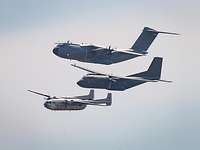


Aid flights and combat operations, the Starfighter scandal and German reunification, traditional names and counterterrorism: more than six decades of eventful history have left their mark on the German Air Force.

The new German Air Force officially came into being on 24 September 1956 when the first ten jet pilots received their pilot badges, the coveted “wings”. The first trainer aircraft with the Bundeswehr emblem – a Piper L-18, a Harvard Mk.4 (T-6) and a Lockheed T-33 jet trainer – were also symbolically handed over during the ceremony held at the Fürstenfeldbruck air base.
During this period, the German Air Force also purchased or received the following aircraft as initial equipment from the USUnited States and Canada: 450 F-84F fighter bombers, 108 RF-84F reconnaissance aircraft, 90 F-86K aircraft and 300 F-86 Sabre Mk.5/Mk.6 aircraft. The French Noratlas was ordered as transport aircraft.
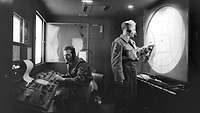
Keeping an eye on Germany’s airspace: military personnel using the radar equipment of a Nike 1974 antiaircraft defence system.
Bundeswehr/Günther OedThe first enlisted volunteers in the Air Force received their letters of appointment in Nörvenich in January 1956. With Lieutenant General Josef Kammhuber’s appointment as first Chief of the German Air Force on 1 June 1957, the course was set for buildup of this armed service. After the first basic service conscripts were called up on 16 January 1958, the necessary expansion of the basic training organisation took place such that four Air Force training regiments had been put into service by mid-1960.
Many courses of training and opportunities for practice, particularly for flight personnel and air defence corps personnel, were established abroad in the years that followed, especially in the USUnited States. Shortly afterwards, the air defence units were equipped with the Nike weapon system. In July 1959, procurement of the HAWK ground-based air defence system was initiated.
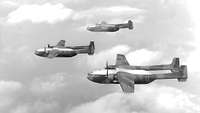
In formation: the Air Force has completed a large number of relief operations throughout its history, starting with the 1960 Noratlas flights to the area affected by the Agadir earthquake.
Bundeswehr/SiwikThe first decisions regarding follow-on weapon systems were already being made as of 1959. In early 1959, the first F-104 Starfighters were ordered from the USUnited States, and arrangements were made for licensed production in Germany. Starting in 1961, the F-104 Starfighters were handed over to the German Air Force along with Fiat G.91 aircraft. In 1963, the German Bundestag approved procurement of the Transall C-160 transport aircraft.
The Air Force had already completed its first relief operation – for the Moroccan city of Agadir, which had been destroyed by an earthquake – in 1960. The first time that the Air Force provided assistance within Germany was during the catastrophic flooding in Hamburg in February 1962. From 1962 to 1969, the transport aircraft completed numerous disaster assistance flights in Italy, Crete, Mali, Portugal, Nigeria, Iran, Tunisia, Algeria and Turkey.
Starting in the mid-1960s with the beginning of the Starfighter scandal, but at the very latest when Lieutenant General Johannes Steinhoff became Chief of the German Air Force in 1966 and NATONorth Atlantic Treaty Organization doctrine changed in 1967, the German Air Force redesigned its concepts, planning and organisation. By the end of General Steinhoff’s term in 1970, these important changes had come together to lay the foundation for the Air Force in the Cold War era of the 1970s and 1980s.
In April 1965, the Defence Committee of the German Bundestag authorised procurement of Bell UH-1D transport helicopters, which were used in the Air Force until 2012. The first three Bell UH-1D aircraft were then handed over to 64 Helicopter Transport Wing in February 1968. The Air Force was fully equipped with this system in the 1970s.
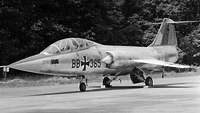
A flying wonder or a “widowmaker”? Aviation enthusiasts’ opinions on the Starfighter combat jet are divided to this day.
Bundeswehr/StorzStarting in 1962, there were a growing number of crashes with F-104G Starfighters, which peaked in 1965 with 26 crashes and the deaths of 15 pilots. In December 1965, the Air Force therefore temporarily suspended the F-104G aircraft’s status as earmarked for NATONorth Atlantic Treaty Organization and launched an investigation into the frequency of the causes of the accidents in order to take appropriate measures. When Lieutenant General Johannes Steinhoff became the third Chief of the German Air Force on 2 September 1966, he initiated a comprehensive situation analysis and had a new concept developed for the Air Force, which also took into account the new “flexible response” strategy that NATONorth Atlantic Treaty Organization had discussed and then introduced in 1967. As a result of these considerations, efforts were made to restructure the Air Force, primarily resulting in a new command structure. Accordingly, the Air Fleet Command, the Air Force Office and the Air Force Support Command were established on 1 October 1970.
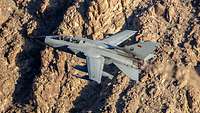
In its element: the Tornado combat jet is ideal for extremely low-flying operations.
Bundeswehr/Johannes HeynThe fall of the Berlin Wall and the collapse of the Warsaw Pact ushered in not only a new geopolitical era, but also radical changes for the German Air Force due to the changed security parameters.
Initially, the armed services in this area were assigned to a “Bundeswehr Eastern Command”. The Chief of the German Air Force decided to assign all the air force units in the former East Germany to a new 5 Air Division. In addition, “command and support groups” were established, and commanders from the “Western Air Force” were employed as commanders in all agencies and formations of the National People’s Army air forces.
All the personnel and weapon systems adopted from the National People’s Army air forces were counted towards the upper limits for materiel and personnel for the reunified German armed forces, which were derived from the provisions of the Treaty on the Final Settlement with Respect to Germany and the Treaty on Conventional Armed Forces in Europe. The resulting structure called for operation of facilities of the former National People’s Army air forces “that are necessary for the operational readiness of the armed forces in the [former East German] territory that acceded” to the Federal Republic of Germany.
This included parts of the airspace surveillance forces and the flying branch, as well as operation of selected ground-based air defence components of the National People’s Army air forces using the (Russian) SA-5 air defence missile system.
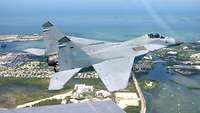
Made in Russia: after German reunification, the German Air Force temporarily also flew MiGMikoyan-Gurewitsch-29 aircraft.
Bundeswehr/Lw WahnAfter the Bundeswehr Eastern Command was disbanded on 30 June 1991, 5 Air Division was completely under the command of the German Air Force as of 1 July 1991. From the beginning, the MiGMikoyan-Gurewitsch-29 fighter aircraft was an anomaly in the Air Force’s flight operations. After the dissolution of the Warsaw Pact and German reunification, 24 MiGMikoyan-Gurewitsch-29 “Fulcrum” fighter aircraft from the inventory of the former National People’s Army were transferred to the German Air Force and employed in accordance with Western principles.
In 1993, the MiGMikoyan-Gurewitsch-29 air proving wing was merged with 35 Fighter Bomber Wing (F-4F Phantom) in the town of Laage near Rostock to form the new 73 Fighter Wing unit. This unit used both MiGMikoyan-Gurewitsch-29 and F-4F Phantom aircraft. On 18 September 1997, the combined 73 Fighter Wing officially entered into service once again with its new traditional name: “Steinhoff”.
After German reunification and the reorganisation of the armed forces, it became necessary to quickly enable the Bundeswehr to participate in international operations. This led to the most extensive restructuring in the history of the German Air Force up to that point. In 1993, the formations were divided into (better-equipped) crisis response forces and (only partially manned and equipped) main defence forces.
Following on recommendations from various commissions, recommendations for the Bundeswehr’s size, structure, training and equipment in the 21st century were submitted in 2000. For the Air Force, the focus was on increased cooperation with industry, as well as further development of service logistics.
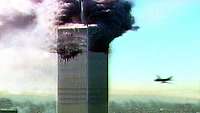
Commercial aircraft as flying bombs: the attacks of 11 September 2001 changed the world.
picture alliance/ROPIThe “renegade” concept NATONorth Atlantic Treaty Organization developed for countering terrorist attacks with aircraft has also been particularly important for the German Air Force. The Air Force was assigned tasks referred to as “German airspace security” in order to distinguish them from NATONorth Atlantic Treaty Organization air policing. Since then, the Air Force has been performing these tasks not only on an operational basis but also through the interagency activities of the National Air Policing Centre. In order to expand the armed forces’ capability for strategic deployability, the Federal Ministry of Defence had already started planning a “future transport aircraft” in the early 1980s. After many years of coordination at the European level, the contract for procurement of the A400M transport aircraft was signed in 2003.
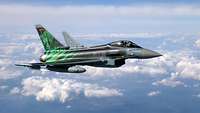
The Air Force employs the Eurofighter combat jet as a fighter aircraft and fighter bomber.
BundeswehrIn November 1997, the German Bundestag decided on the procurement of 180 Eurofighter combat aircraft within the scope of modernising the Air Force’s airborne weapon systems, launching one of the most controversial armament programmes Germany has seen in recent decades. Some new NATONorth Atlantic Treaty Organization members such as the Baltic states and Iceland did not have enough air defence forces of their own. For that reason, the German Air Force has participated in Baltic Air Policing – a mission all NATONorth Atlantic Treaty Organization member nations contribute to on a rotational basis – with F-4F Phantom and Eurofighter aircraft several times since 2005.
The “army of unity” soon became an “army on operations”. The German Air Force started this transition with Operation Ace Guard, which the NATONorth Atlantic Treaty Organization Allied Mobile Forces conducted in Turkey in spring 1991 because of the Gulf War. Other operations involving the Air Force include the 1991 UNUnited Nations mission in Cambodia, participation in the international airlift to Sarajevo in Bosnia and Herzegovina starting in 1992 during the Yugoslav Wars, and the 1993 UNUnited Nations mission in Somalia. All of these operations involved at least the Air Force’s transport aviation.
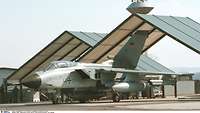
Headed for Kosovo: one of the operational wing’s Tornado aircraft prepares for takeoff in Piacenza, Italy.
Bundeswehr/Detmar ModesAir Force personnel ultimately had to prove themselves on their first armed operation in 1995, when German Tornado ECRElectronic Combat Reconnaissance aircraft participated in Operation Deliberate Force with 1 Operational Wing, which was established especially for this purpose, based in Piacenza, Italy. Operation Allied Force followed in 1999, with 14 German Air Force Tornado aircraft participating in the NATONorth Atlantic Treaty Organization operation in Kosovo. The Air Force supported NATONorth Atlantic Treaty Organization in the Balkans until 2001.
As a result of the 2001 terror attacks in the USUnited States, the German Bundestag decided in December 2001 that the Bundeswehr would participate in the ISAFInternational Security Assistance Force mission in Afghanistan. Since then, this operation abroad has been a key task for the Bundeswehr and the Air Force. For the Air Force, this operation began with responsibility for operational management of the airport in Kabul in 2003 and 2004. The Air Force also handled strategic air transport to and from Germany, as well as tactical air transport in the theatre of operations, with Airbus A310 and Transall C-160 aircraft. This involved not only German military personnel participating in the AEW&C operations, but also the Air Force handling the strategic aeromedical evacuation operations (STRATAIRMEDEVACStrategic Air Medical Evacuation ).
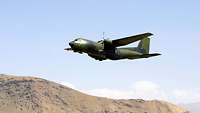
The Air Force’s workhorse, the Transall transport aircraft, has also proven itself on operations in Afghanistan.
BundeswehrStarting in 2007, air reconnaissance capabilities were added to the German ISAFInternational Security Assistance Force contingent’s set of forces and capabilities. In addition, the German Air Force provided six Recce Tornado aircraft at the Mazar-i-Sharif aerodrome for the operational wing there until November 2010. After that, the Heron 1 unmanned reconnaissance system bore the brunt of aerial reconnaissance and surveillance tasks for Regional Command North in Afghanistan. From 2010 until the end of June 2012, the Air Force also participated in training the new Afghan task forces for training and protection, the Operational Mentoring and Liaison Teams (OMLT) and the police OMLTs, with force protection forces and personnel from the surface-to-air-missile forces and sometimes from the training organisation.
In the 1960s, tradition was cultivated to such an extent that traditional names were bestowed upon three different wings in 1961: “Richthofen” for 71 Fighter Wing, “Boelcke” for 31 Fighter Bomber Wing and “Immelmann” for 51 Reconnaissance Wing. One special feature that still applies to this day is that personnel are allowed to wear a sleeve band on their uniforms with the traditional name of their unit. As a further expression of traditions, the command flags were handed over to the Air Force units in 1965. In addition, the German Air Force Memorial was handed over to the Air Force on 20 May 1966 as a central memorial in Fürstenfeldbruck.
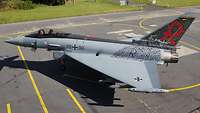
R is for “Richthofen”: 71 Tactical Air Wing Richthofen is named after the “Red Baron”, a flying ace from World War I.
Bundeswehr/Daniel RedellUpon request by the wing commander of what was then 74 Fighter Wing, this wing received the traditional name “Mölders” on 22 November 1973. In 1977, the main auditorium of the new Air Force Officer School in Fürstenfeldbruck was named “Ludger Hölker hall”, the first name to honour a member of the Federal Republic of Germany’s Air Force. On 15 September 1964, Ludger Hölker had crashed in a flight accident in a T-33 of 32 Fighter Bomber Wing, losing his life while ensuring that the aircraft would not crash into the community of Strassberg. As of September 1997, what is now 73 Tactical Air Wing (formerly known as 73 Fighter Wing) is also named “Steinhoff” after the former Chief of the German Air Force. Due to a decision by the German Bundestag, the name “Mölders” was retracted from 74 Fighter Wing in 2005 because members of the Condor Legion, which fought in the Spanish Civil War from 1936 to 1939, may no longer be commemorated. Since its publication in 2003, the mission statement for “Team Air Force” has become a key element of the Air Force’s traditions.